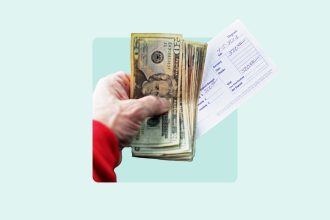fizkes/Getty Images: Illustration by Issiah Davis/Bankrate
Key takeaways
- A first-time homebuyer grant can help you cover a down payment and closing costs. You don’t have to repay the grant funds.
- A grant might come from a bank or mortgage lender, a non-profit or other organization.
- A grant typically won’t cover all of your home-buying expenses — you’ll still need to contribute some of your own money to the purchase.
Coming up with a down payment on a home can feel impossible — especially if it’s your very first home. The good news is that there are many first-time homebuyer grants available that can help you bridge the savings gap to get into a home. These programs are typically offered by banks or non-profit organizations, but state and local governments also offer them.
What is a first-time homebuyer grant?
You’ll find many options for financial help as a first-time homebuyer, but there’s one key piece that separates grants from other forms of help: You don’t ever have to pay the money back. The funds can help you cover a down payment on a home, as well as the closing costs you’ll need to pay before you move in. Some grant programs are available to those who have purchased a home before, too.
Because they’re essentially free money, first-time homebuyer grants differ from other types of down payment assistance programs that require you to repay the funds at some point, or stay in the home long enough for the funds to be forgiven. First-time buyer grants also differ from affordable mortgage programs that come with perks like a lower mortgage rate and lower mortgage insurance premiums.
How to qualify for a first-time homebuyer grant
Not all first-time homebuyers are eligible for first-time homeowner grants. These programs tend to be geared toward those classified as a low- or moderate-income borrower, and that definition depends on your income and where you want to live.
While eligibility requirements vary, most grant programs share a few common elements, including:
- Income limits: Many grant programs designate households that earn 80 percent or less of the area median income (AMI) as “low-income,” and limit the program to those in that range. The income limits also vary based on how many people are in the household.
- Home price limits: Again, these limits vary widely based on your state or local housing market.
- Your contribution: Many grants for first-time homebuyers stipulate that the buyer needs to chip in some cash. One common ask is either 1 percent of the purchase price or $1,000, whichever is greater.
- Your residence status: You typically can only get a grant to help buy a home you’ll actually make your primary residence, not one you’ll rent out to someone else or use as a second home.
- Additional education: Many grant programs require you to complete a homebuyer education course before receiving the funds.
8 first-time homebuyer grants to consider
1. National Homebuyers Fund
The nonprofit National Homebuyers Fund sponsors down payment and closing cost grants that can total up to 5 percent of your home’s purchase price. You don’t actually have to be a first-time homebuyer to qualify, but you do need to find a mortgage lender that participates in the program and forgives the funding. You can call the organization for help finding local lenders at 866-643-4968.
2. Bank of America grant programs
Bank of America offers two grant options to help with a down payment and closing costs: the America’s Home Grant and Down Payment Grant programs. America’s Home Grant provides up to $7,500 in lender credits for closing costs, while the Down Payment Grant provides up to $10,000 in down payment help. You’ll have to get your mortgage from Bank of America, however, and the Down Payment Grant could be counted as taxable income.
3. Chase Homebuyer Grant
The Chase Homebuyer Grant is available to homebuyers in select areas of the U.S. that meet specific census tract requirements. The program provides grants of up to $7,500 that can primarily go toward buying down your interest rate. However, you can also use the money for fees associated with the mortgage or down payment costs. The Homebuyer Grant is available to applicants who are seeking the bank’s DreaMaker loan, or a conventional, FHA or VA mortgage.
4. Wells Fargo grant programs
Wells Fargo offers two types of assistance grants: down payment help through the Homebuyer Access grant and the Dream. Plan. Home. credit for closing costs. The former provides up to $10,000 to eligible borrowers in the metro areas of Atlanta, Baltimore, Charlotte, Dallas, Minneapolis-St. Paul, New Jersey, New York, Philadelphia and Washington, D.C. The closing cost credit provides up to $5,000 to lower-income borrowers in specific areas. As with other grants offered by banks and lenders, you’ll need to get your mortgage from Wells Fargo to qualify, as well as meet the income and location requirements. You can check your eligibility on the Wells Fargo website.
5. HomeReady and Home Possible credits
If you plan to get a HomeReady or Home Possible conventional loan between now and February 2025, you might also qualify for a $2,500 credit if your income falls within the scope of “very low income,” meaning 50 percent or less than the median income for your area. You can put the credit toward your down payment or closing costs.
6. State and local first-time homebuyer grants
Many states and cities offer grant programs for first-time homebuyers, especially if you’re relocating for work. Check with your state’s housing finance authority or real estate agent for more.
A local mortgage lender might also be able to point you toward free money. For example, First Federal Bank of Kansas City offers eligible buyers a grant of up to $5,000. New York-based ESL Federal Credit Union has a matching program for Black and Latino first-time homebuyers that can provide up to $10,500 of grant money. Tri Counties Bank in California offers four-to-one matching grants of as much as $30,800.
7. Good Neighbor Next Door program
Available to law enforcement officers, teachers, firefighters and emergency medical technicians, the Good Neighbor Next Door program overseen by the U.S. Department of Housing and Urban Development offers a 50 percent discount on homes in designated revitalization areas. As long as you live there for three years, you get the property for half off the list price with no need to pay that discount back.
8. HomePath Ready Buyer program
The HomePath Ready Buyer program comes courtesy via Fannie Mae. With this program, you can get up to 3 percent of your home’s purchase price to help with closing costs, and potentially other savings opportunities, as well. However, you’re limited in what you can buy — it has to be a HomePath property, a home owned by Fannie Mae. These are most often foreclosures that might need significant work.
How to apply for a first-time homebuyer grant
Most home-buying grants require a minimum credit score. To apply, you typically must provide extensive income and assets documentation, including at least two months of recent pay stubs and employment verification.
Depending on which grant you’re after, you might be able to apply for the grant at the same time as you apply for your mortgage. Otherwise, you’ll need to follow the organization’s guidelines. Many allow you to begin the application process online.
Other assistance for first-time homebuyers
If you can’t find grants for first-time homebuyers that work for you, you aren’t out of luck just yet. There are other low-cost first-time homebuyer loans and programs. You might also qualify for a forgivable loan, which could end up functioning much like a grant (if you meet certain requirements, you never have to repay the loan).
Here are a few options to explore:
- DPA second mortgages – A down payment assistance (DPA) second mortgage is available through many state housing finance agencies. In a DPA second mortgage program, you’ll apply for a 30-year mortgage to finance the home and then another mortgage for a smaller amount to help with the down payment or closing costs. Just like the first mortgage, this second loan comes with an interest rate (although it might be lower than the first) that you repay over time.
- DPA deferred-payment loans – Instead of requiring you to immediately start paying back the down payment assistance funds, some programs allow you to defer these payments until you sell your home, refinance or pay off your mortgage. The assistance won’t accrue interest in the meantime, so the amount you owe won’t grow.
- DPA forgivable loans – Forgivable loans are the closest cousin to homebuying grants because they can wind up being free — but only if you live in the home long enough. For example, you might be able to borrow $5,000 to help toward a down payment, with the loan balance reduced every month over 10 years. If you stay in the home for 10 years, it’ll be completely forgiven. If you move before that time frame’s up, you’ll need to pay back a portion of the loan.
- Individual Development Accounts (IDAs) – IDAs are matched savings accounts designed for those within certain work and income parameters, typically those with a low income. IDAs are offered through some public housing organizations and private nonprofits and usually provide a dollar-for-dollar match, up to a specific amount, for savings goals, including a down payment and closing costs.
FAQ
-
The best first-time homebuyer loan for you depends on your personal situation and what you can qualify for. For example, if you have a credit score lower than the minimum 620 needed for a conventional loan, you might explore an FHA loan, as this loan type has more lenient credit score requirements.
-
To qualify for a first-time homebuyer grant, mortgage or other assistance program, a first-time homebuyer is considered someone who has never owned a home before or who has not owned a home in the past three years.
Read the full article here
















